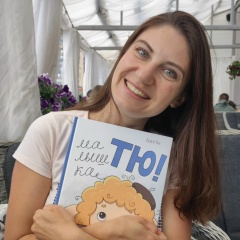"Рождество овцы" Харуки Мураками я читала на русском в институте. Мураками люблю, эхоны люблю, но к "Рождеству" - и тогда, и сейчас - отношение прохладное. Тем не менее книга достойна большего внимания, чем ей уделяют.
Искала на нее рецензии, отзывы, пишут в основном общие слова о том, что это все тот же Мураками, но милее и без особой идеи. Единственное, что пишут о книге по существу - что она является детским переложением сюжета романа "Охота на овец". Вот он ключ. Мураками - постмодернист, а эта книга тот самый прием "пастиш" в полный рост. "Пастиш - иная сюжетная версия первичного (авторского) произведения с сохранением авторского стиля, персонажей, антуража, времени действия и т. д.".Та-дааа-м. Это не для детей. Мураками создал красивую самоцитату и пересказал в ней свою основную мысль.
Коваленин, который переводил "Охоту на овец" пишет в книге "Суси-нуар" про структуру романа, постоенную как кольцевая композиция - главный герой в конце должен понять глупость идей навязанных ему из вне, вернуться в начало и радоваться самому себе. Так происходит и в Рождестве. Овце навязывают писать музыку ко дню Святого овцы, потом профессор сообщает ему, что он проклят раз ел еду с дыркой в определенный день (пончики) и поэтому не может писать, потом он снова и снова делает что ему говорят, но в итоге он снова оказывается дома уже без проклятия, без проблем и с новым пианино.
Та же история со связью между местом действия и исчезновением персонажей из предыдущих сцен. Коваленин пишет, что герой "Охоты на овец" , для того чтобы достигнуть высшей точки своего развития должен пройти несколько миров, а его спутники могут существовать в пределах только одного мира, поэтому и не следуют с ним до конца. В "Рождестве овцы" это даже понятнее и нагляднее. Парень со скрученным как у пончика "косичка" лицом встречает овцу в яме, белее его сменяют близняшки 208 и 209, которые тоже с ним только пока он идёт по лесу, у утеса они его оставляют, чтобы он встретился с кайрой. Та, хоть и схитрив, но все же доставляет его на новую локацию.
Ещё нашла размышления японки над тем, что имел ввиду автор под тем, что дырявые пончики ведут к проклятию. Кажется, она вела к тому, что мы принимаем дыры за круги, объединяющие людей, от этого мы падаем и попадаем под проклятия.
Чтобы попасть туда, где якобы с овцы снимут проклятье, ему нужно взять с собой еду без дырок и он берёт скрученные пончики (косичкой). Девушка пишет, что все мы по хорактеру либо дырявые пончики ????, либо скрученные. Без комментариев.
#японские_записки_матрёшкой #харукимураками #рождествоовцы
Искала на нее рецензии, отзывы, пишут в основном общие слова о том, что это все тот же Мураками, но милее и без особой идеи. Единственное, что пишут о книге по существу - что она является детским переложением сюжета романа "Охота на овец". Вот он ключ. Мураками - постмодернист, а эта книга тот самый прием "пастиш" в полный рост. "Пастиш - иная сюжетная версия первичного (авторского) произведения с сохранением авторского стиля, персонажей, антуража, времени действия и т. д.".Та-дааа-м. Это не для детей. Мураками создал красивую самоцитату и пересказал в ней свою основную мысль.
Коваленин, который переводил "Охоту на овец" пишет в книге "Суси-нуар" про структуру романа, постоенную как кольцевая композиция - главный герой в конце должен понять глупость идей навязанных ему из вне, вернуться в начало и радоваться самому себе. Так происходит и в Рождестве. Овце навязывают писать музыку ко дню Святого овцы, потом профессор сообщает ему, что он проклят раз ел еду с дыркой в определенный день (пончики) и поэтому не может писать, потом он снова и снова делает что ему говорят, но в итоге он снова оказывается дома уже без проклятия, без проблем и с новым пианино.
Та же история со связью между местом действия и исчезновением персонажей из предыдущих сцен. Коваленин пишет, что герой "Охоты на овец" , для того чтобы достигнуть высшей точки своего развития должен пройти несколько миров, а его спутники могут существовать в пределах только одного мира, поэтому и не следуют с ним до конца. В "Рождестве овцы" это даже понятнее и нагляднее. Парень со скрученным как у пончика "косичка" лицом встречает овцу в яме, белее его сменяют близняшки 208 и 209, которые тоже с ним только пока он идёт по лесу, у утеса они его оставляют, чтобы он встретился с кайрой. Та, хоть и схитрив, но все же доставляет его на новую локацию.
Ещё нашла размышления японки над тем, что имел ввиду автор под тем, что дырявые пончики ведут к проклятию. Кажется, она вела к тому, что мы принимаем дыры за круги, объединяющие людей, от этого мы падаем и попадаем под проклятия.
Чтобы попасть туда, где якобы с овцы снимут проклятье, ему нужно взять с собой еду без дырок и он берёт скрученные пончики (косичкой). Девушка пишет, что все мы по хорактеру либо дырявые пончики ????, либо скрученные. Без комментариев.
#японские_записки_матрёшкой #харукимураками #рождествоовцы
I read "Christmas of the Sheep" by Haruki Murakami in Russian at the institute. I love Murakami, I love Ekhons, but to "Christmas" - both then and now - the attitude is cool. Nevertheless, the book deserves more attention than it gets.
I was looking for reviews, reviews, they write mostly general words that this is still the same Murakami, but nicer and without much idea. The only thing they write about the book in essence is that it is a children's adaptation of the plot of the novel "Sheep Hunt". Here is the key. Murakami is a postmodernist, and this book is a full-length pastiche. "Pastish is a different plot version of the primary (author's) work with the preservation of the author's style, characters, entourage, time of action, etc." Ta-daaa-m. This is not for children. Murakami created a beautiful self-quote and recounted his main idea in it.
Kovalenin, who translated "The Hunt for the Sheep", writes in the book "Susi Noir" about the structure of the novel built as a ring composition - the main character at the end must understand the stupidity of ideas imposed on him from outside, return to the beginning and enjoy himself. This is what happens in Christmas. The sheep are forced to write music for the day of the Holy Sheep, then the professor tells him that he is cursed once he ate food with a hole on a certain day (donuts) and therefore cannot write, then he does what he is told again and again, but in the end he turns out to be again at home without a curse, no problem and with a new piano.
It's the same story with the connection between the scene and the disappearance of characters from previous scenes. Kovalenin writes that the hero of the "Hunt for Sheep", in order to reach the highest point of his development, must go through several worlds, and his companions can exist within only one world, and therefore do not follow him to the end. In "Christmas of the Sheep" it is even clearer and clearer. A guy with a face twisted like a donut "pigtail" meets a sheep in a pit, whiter than he is replaced by twins 208 and 209, who are also with him only while he walks through the forest, at the cliff they leave him to meet with a murre. She, although cunning, nevertheless delivers him to a new location.
I also found a Japanese woman thinking about what the author meant by the fact that holey donuts lead to damnation. It seems that it led to the fact that we mistake holes for circles that unite people, from this we fall and fall under the curse.
To get to the place where the curse is supposedly removed from the sheep, he needs to take food without holes with him and he takes twisted donuts (in a pigtail). The girl writes that we are all either holey donuts ????, or twisted ones. No comment.
#japanese_scrap_matryoshka # harukimurakami # christmas
I was looking for reviews, reviews, they write mostly general words that this is still the same Murakami, but nicer and without much idea. The only thing they write about the book in essence is that it is a children's adaptation of the plot of the novel "Sheep Hunt". Here is the key. Murakami is a postmodernist, and this book is a full-length pastiche. "Pastish is a different plot version of the primary (author's) work with the preservation of the author's style, characters, entourage, time of action, etc." Ta-daaa-m. This is not for children. Murakami created a beautiful self-quote and recounted his main idea in it.
Kovalenin, who translated "The Hunt for the Sheep", writes in the book "Susi Noir" about the structure of the novel built as a ring composition - the main character at the end must understand the stupidity of ideas imposed on him from outside, return to the beginning and enjoy himself. This is what happens in Christmas. The sheep are forced to write music for the day of the Holy Sheep, then the professor tells him that he is cursed once he ate food with a hole on a certain day (donuts) and therefore cannot write, then he does what he is told again and again, but in the end he turns out to be again at home without a curse, no problem and with a new piano.
It's the same story with the connection between the scene and the disappearance of characters from previous scenes. Kovalenin writes that the hero of the "Hunt for Sheep", in order to reach the highest point of his development, must go through several worlds, and his companions can exist within only one world, and therefore do not follow him to the end. In "Christmas of the Sheep" it is even clearer and clearer. A guy with a face twisted like a donut "pigtail" meets a sheep in a pit, whiter than he is replaced by twins 208 and 209, who are also with him only while he walks through the forest, at the cliff they leave him to meet with a murre. She, although cunning, nevertheless delivers him to a new location.
I also found a Japanese woman thinking about what the author meant by the fact that holey donuts lead to damnation. It seems that it led to the fact that we mistake holes for circles that unite people, from this we fall and fall under the curse.
To get to the place where the curse is supposedly removed from the sheep, he needs to take food without holes with him and he takes twisted donuts (in a pigtail). The girl writes that we are all either holey donuts ????, or twisted ones. No comment.
#japanese_scrap_matryoshka # harukimurakami # christmas




У записи 7 лайков,
0 репостов,
269 просмотров.
0 репостов,
269 просмотров.
Эту запись оставил(а) на своей стене Ира Батуева



























